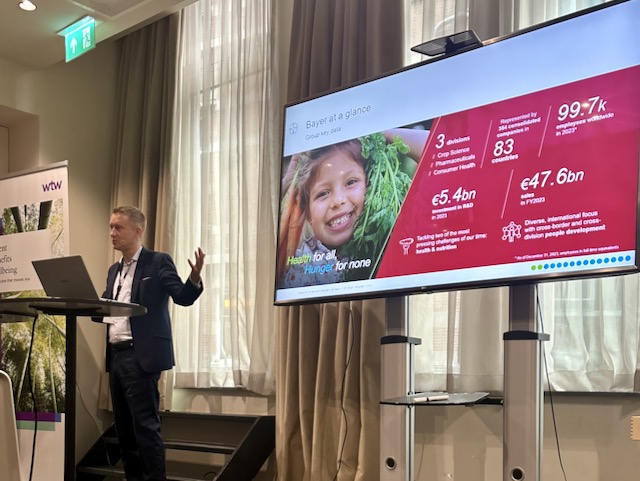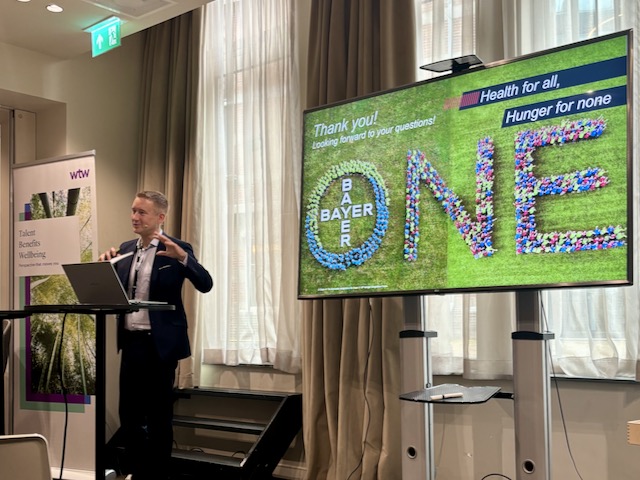

I recently had the privilege of opening the 2024 Merger Integration Forum as the keynote speaker, an event organized by Thought Leader Global. This platform, renowned for bringing together leaders and experts in navigating complex business transformations, provided the perfect space to share insights from one of the most challenging and rewarding projects of my career: managing the post-merger integration in over 70 countries of the largest acquisition in European history.
This $63 billion aquisition and integration was significant stride toward advancing Bayer’s mission: “Health for All, Hunger for None.”
Delivering the keynote was both an honor and a humbling experience. It was an opportunity to reflect on the lessons learned from leading this monumental project over past years, which spanned over all continets and required meticulous coordination, adaptability, and cultural sensitivity – of course supported by amazing teams all around the globe. Each country brought its unique regulatory environments, market dynamics, and cultural nuances, making the integration process a profound learning experience.
Opening the forum set the stage for a day of rich discussions and knowledge-sharing. I shared with the audience the critical role that communication, collaboration, and a people-first approach played in the success of the project. Managing the alignment of two massive organizations taught me that while strategies and numbers are crucial, it’s the trust and engagement of employees, stakeholders, and clients that ultimately determine the success of any merger.
The event itself was inspiring, as it brought together some of the brightest minds in business transformation. Hearing about the innovative strategies and solutions implemented by others reminded me of the collective strength we have as a professional community. The diversity of perspectives enriched the dialogue, and I walked away with a deeper appreciation for the value of collaboration.
Of course, I did not shy away from sharing some of the challenges. A merger of this scale is not without its complexities, from aligning organizational cultures to navigating regulatory hurdles. Sharing these experiences provided an honest view of what it takes to manage such projects and underscored the importance of flexibility and resilience.
The opportunity to open the forum as keynote speaker was a moment of reflection and celebration, not just for me, but for the incredible teams who made the integration a success. Their hard work and dedication were a testament to what is possible when diverse groups come together with a shared vision.
To anyone involved in mergers or large-scale transformations, my advice is to prioritize communication, stay adaptable, and always keep the human element at the forefront. These projects are not just about financial outcomes, they’re about building bridges, fostering collaboration, and creating sustainable success.
As I concluded my keynote and the forum unfolded, I felt a renewed sense of purpose and energy. Events like this are a powerful reminder of the value of shared experiences and continuous learning. I am grateful for the opportunity to contribute to this dialogue and look forward to applying these lessons to future challenges.
Source 1 – Source 2 – Source 3
The facts of the Deal
Here are the key facts about the Monsanto acquisition and integration at Bayer:
- Acquisition Overview: Bayer AG acquired Monsanto in 2018 for $63 billion, making it one of the largest acquisitions in European history.
- Global Integration Scope: The integration involved coordinating operations in over 70 countries, encompassing diverse regulatory, cultural, and market environments.
- Strategic Objectives: The acquisition aimed to strengthen Bayer’s position in the global agricultural market by combining its expertise in crop science with Monsanto’s innovations in seeds and traits.
- Cultural and Organizational Alignment: A key challenge was merging Bayer’s and Monsanto’s distinct corporate cultures and aligning their business strategies.
- Legal and Reputational Challenges: Post-acquisition, Bayer faced significant legal challenges and public scrutiny due to lawsuits related to Monsanto’s glyphosate-based product, Roundup.
- Employee Integration: The merger required the alignment of thousands of employees globally, with a focus on retaining talent and ensuring a smooth transition.
- Innovation Synergy: The combined entity aimed to leverage innovation to address global agricultural challenges, including sustainability and food security.
- Lessons Learned: The integration highlighted the importance of communication, stakeholder engagement, and adaptability in managing mergers of this scale.
The EU-Ranking
European companies have engaged in several of the world’s largest mergers and acquisitions. Below is a list of some of the most significant deals by European firms, ranked by their approximate deal value:
1. Vodafone’s Acquisition of Mannesmann (1999): $183 billion
Vodafone, a UK-based telecommunications company, acquired German industrial conglomerate Mannesmann in what remains the largest acquisition in history. This deal marked a turning point in the global telecom industry, showcasing the rapid globalization of markets.
2. AB InBev’s Acquisition of SABMiller (2016): $103 billion
Belgian-Brazilian brewing giant Anheuser-Busch InBev purchased UK-based SABMiller, creating the world’s largest beer company. The acquisition significantly consolidated the global brewing industry.
3. Royal Dutch Shell’s Acquisition of BG Group (2016): $70 billion
Anglo-Dutch oil company Royal Dutch Shell acquired British gas company BG Group, boosting its portfolio in liquefied natural gas and strengthening its global energy presence.
4. Glaxo Wellcome’s Merger with SmithKline Beecham (2000): $76 billion
Two British pharmaceutical powerhouses, Glaxo Wellcome and SmithKline Beecham, merged to form GlaxoSmithKline (GSK). This deal established one of the world’s largest pharmaceutical companies.
5. Bayer’s Acquisition of Monsanto (2018): $66 billion
German pharmaceutical and life sciences company Bayer acquired U.S.-based Monsanto to strengthen its agricultural division, though the acquisition faced backlash due to Monsanto’s controversies.
6. Sanofi’s Acquisition of Aventis (2004): $65 billion
French pharmaceutical company Sanofi-Synthélabo acquired Franco-German rival Aventis, forming one of the largest pharmaceutical companies in the world, with a focus on innovative drug development.
7. TotalFina’s Merger with Elf Aquitaine (2000): $54 billion
French oil companies TotalFina and Elf Aquitaine merged, creating TotalFinaElf (now TotalEnergies), a major player in the global energy sector.
8. Enel’s Acquisition of Endesa (2007): $52.5 billion
Italian energy company Enel, in partnership with Spanish firm Acciona, acquired Spanish utility Endesa, expanding its footprint across Europe and Latin America.
9. Deutsche Telekom’s Acquisition of VoiceStream Wireless (2000): $50.7 billion
German telecommunications company Deutsche Telekom entered the U.S. market by acquiring VoiceStream Wireless, which later became T-Mobile US, a key player in the American telecom market.
10. BNP’s Merger with Paribas (1999): $20 billion
French banks Banque Nationale de Paris (BNP) and Paribas merged to create BNP Paribas, establishing one of Europe’s largest and most diversified banking groups.
Let me know if you need further adjustments!
These transactions have significantly shaped the global corporate landscape, reflecting European companies’ strategic efforts to expand their global footprint and diversify their operations across various industries.
